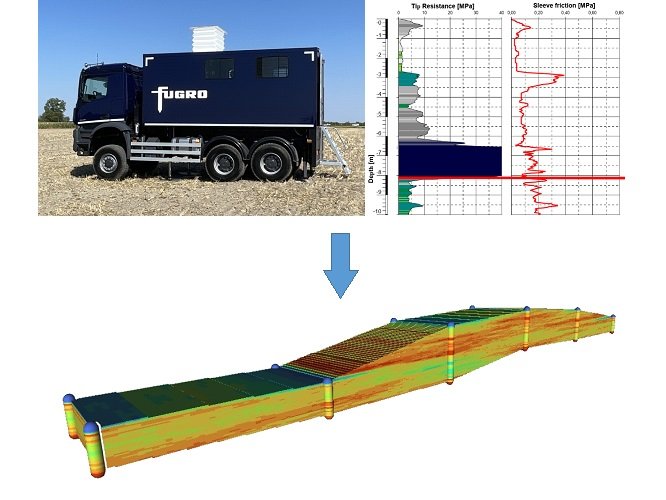News feed
Upcoming BME Development Could Save Big Construction Projects Hundreds of Millions
2024. 09. 13.
The new method, developed in partnership with a company, Fugro, uses a learning algorithm to speed up the groundwork.
It is reasonable to assume that the huge reinforced concrete structures makes large structurally complete construction more expensive. It is basically true but surprisingly, less spectacular processes, such as preliminary soil exploration and foundation design, also eat up a lot of money and time. Without knowing the stratification and other characteristics of the soil, it is not possible to start the foundation work responsibly.
In practice, exploration involves drilling and field investigation (probing). The most commonly used probing method is a test known as CPT, where engineers collect data per 2 centimetres from the subsoil under test. In case of buildings, probing is carried out 40-50 metres apart on average, so in total less than one thousandth of the soil is probed. ‘After that, experience, engineering, consideration and intuition come to the fore when preparing the site model,’ András Mahler, vice dean of BME Faculty of Civil Engineering said, who was asked by the bme.hu about a development funded by the EU with almost half a billion euros.

photo: Pexels.com
Within the framework of the two-year project, the researchers of BME Faculty of Civil Engineering and the experts of the subsidiary in Hungary of Fugro international company headquartered in the Netherlands jointly elaborate a system which is able to use data coming from probing more efficiently than ever. The aim is to automate and optimize modelling and pile design to reduce weeks of engineering work to a few days and quantify the uncertainty caused by the ground environment. Through this fastness, we might be provided with important and for informed decision-making much needed information as soon as the period of soil exploration and conceptual design,’ András Mahler explained.
It is planned that this method, which also use AI, will become a tested service by 2026, saving up to hundreds of millions of euros in costs for some major investments, and hopefully, by the help of Fugro, one of the world leader geotechnical company, it will become widespread. The corporate group has a huge amount of data on construction sites and subsoils from all over the world, which makes the learning process better and better.
‘A statistical approach has been used for several things in this segment, but I don't know of any development that includes a learning algorithm, too,’
said András Mahler when asked about the novelty of the concept.
But how exactly does it work? Based on the database created from the results of probing, using geostatistical methods, several soil stratifications occurring with the same probability can be generated. This can be used to determine the types of soil that may be present and the likelihood of their presence. On parts where typically the same type of soil is shown in the simulation, the level of uncertainty is low, whereas it is higher, where the soil is divers.
When calculating pile foundation, a database of all technically possible foundation options will be created and using that, the algorithm will calculate the optimal solution. In time, the integrated system might even be able to complete the design process without the intervention of an engineer but the basic aim of it is to allow engineers to focus on the essential design and decision-making parts. For that aim, the new method can provide all relevant data and information on the soil. This knowledge will be particularly useful for large construction projects carried out on large sites, as it allows for a technically safer, optimal foundation. Of course, this is also highly significant in terms of environmental protection.

József Pusztai, the managing director of the Fugro’s Hungarian subsidiary, worked and obtained his PhD at the BME and that is how the BME and Fugro got connected. ‘We have known the experts of the Department for a long time and we came up with the idea of the development together,’ Balázs Karner, the project manager of Fugro Consult Kft. said to the bme.hu. He reckons that the potential of the service is already huge in Hungary and it is difficult to estimate how much demand there is for it worldwide. ‘The spectrum is really broad, and contractors can already benefit of the new service during the tendering period,’ he said.
Through the knowledge accumulated at the BME in the course of the project, both faculty members and students can benefit of the development. The experience obtained may significantly effect the development of the educational methods and materials.
The project has been awarded a grant of HUF 484.22 million from the NKFI's Innovation Fund.
gp
